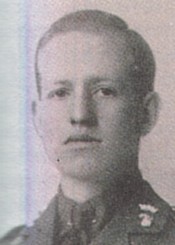Geoffrey Cather facts for kids
Quick facts for kids
Geoffrey St George Shillington Cather
|
|
|---|---|

Geoffrey St. George Shillington Cather
|
|
| Born | 11 October 1890 Streatham Hill, London, England |
| Died | 2 July 1916 (aged 25) Beaumont-Hamel, France |
| Allegiance | |
| Service/ |
|
| Years of service | 1914–1916 † |
| Rank | Lieutenant |
| Unit | 9th Battalion, The Royal Irish Fusiliers |
| Battles/wars | World War I |
| Awards | Victoria Cross |
Geoffrey St. George Shillington Cather (born October 11, 1890 – died July 2, 1916) was a very brave soldier. He received the Victoria Cross, which is the highest award for courage in battle. This special medal is given to soldiers from the United Kingdom and Commonwealth countries. Geoffrey Cather was a soldier in the Royal Irish Fusiliers during World War I. He was given the Victoria Cross after he died, for his amazing actions on July 1, 1916, during the Battle of the Somme.
Contents
Early Life of Geoffrey Cather
Geoffrey Cather was born in Streatham Hill, a part of south-west London, England. His birthday was October 11, 1890. His father, R. G. Cather, worked for a tea company called Joseph Tetley & Co.. His mother, Margaret, was the sister of a politician named David Graham Shillington.
Geoffrey went to school at Hazelwood School in Limpsfield. Later, he attended Rugby School. However, he had to leave school when he was a teenager because his father passed away. He then started working for his father's tea company. From 1911 to 1914, he traveled a lot for work in the United States and Canada.
Joining the First World War
On September 3, 1914, Geoffrey Cather joined the British Army. He had some military experience already. From 1909 to 1911, he had served for two years in a group called the Territorial Force.
In May 1915, he asked to join the Royal Irish Fusiliers. He chose this because both of his parents were from Northern Ireland. He was made a lieutenant in the 9th Battalion of the Royal Irish Fusiliers. This battalion was part of the 36th (Ulster) Division.
In October 1915, Geoffrey was sent to the Western Front in France. This was where much of the fighting happened. He was quickly promoted to lieutenant and became the adjutant for his battalion. An adjutant is an officer who helps with administrative tasks and keeps things organized.
Bravery at the Battle of the Somme
In July 1916, Geoffrey's division took part in the Battle of the Somme. This was one of the biggest and bloodiest battles of World War I. On July 1, 1916, which was the first day of the battle, Geoffrey's battalion had a mission. They were supposed to capture Beaucourt Station, near Beaumont-Hamel.
However, many soldiers from his battalion were hurt or killed. The Irish soldiers had to go back to where they started. They had to leave many wounded soldiers behind in an area called "no man's land". This was the dangerous space between the two armies' trenches.
That night, Geoffrey Cather bravely went out into "no man's land". He was looking for wounded soldiers and trying to bring them back to safety. He managed to rescue three men before it got too dark. The next morning, he went out again to find more survivors. Sadly, he was killed by machine gun fire during this rescue attempt.
Victoria Cross Award
Because of his incredible bravery, Geoffrey Cather was awarded the Victoria Cross (VC). This medal was created in 1856. It is the highest award for courage a soldier in the British Empire could receive.
The official statement about his award said:
For most conspicuous bravery. From 7 p.m. till midnight he searched 'No Man's Land', and brought in three wounded men. Next morning at 8 a.m. he continued his search, brought in another wounded man, and gave water to others, arranging for their rescue later. Finally, at 10.30 a.m., he took out water to another man, and was proceeding further on when he was himself killed. All this was carried out in full view of the enemy, and under direct machine gun fire and intermittent artillery fire. He set a splendid example of courage and self sacrifice.
—The London Gazette, 9 September 1916
Geoffrey Cather was first buried near where he died. But later, his grave was lost. His name is now listed on the Thiepval Memorial to the Missing. This memorial is near Thiepval in Picardy, France. There is also a special plaque in his memory at Hazelwood School, where he studied. His name is also on the Royal Fusiliers Regimental Memorial in St Anne's Cathedral in Belfast.
Geoffrey Cather's Medals
King George V gave Geoffrey Cather's Victoria Cross medal to his mother. This happened on March 31, 1917, at Buckingham Palace in London.
Besides the Victoria Cross, Geoffrey was also given other medals. These included the 1914–15 Star, the British War Medal, and the Victory Medal. Later, his brother gave his Victoria Cross and other medals to the Royal Irish Fusiliers Museum. This museum is in Armagh, Northern Ireland, where they are now displayed.

